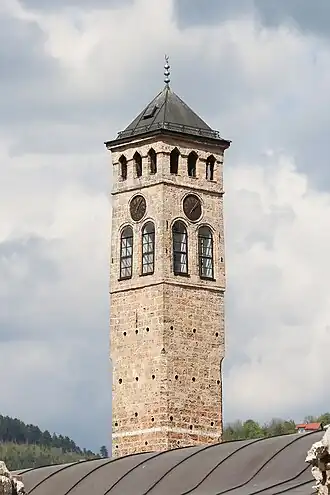Sarajevo Clock Tower
| Sarajevo Clock Tower | |
|---|---|
| Native name Sarajevska sahat-kula (Bosnian) | |
 Sarajevo Clock Tower above roofs of surrounding buildings | |
| Type | Clock tower |
| Location | Baščaršija |
| Coordinates | 43°51′33″N 18°25′43″E / 43.85920831098188°N 18.42860514502344°E |
| Height | 30 m |
| Founded | early 17th century |
| Founder | Gazi Husrev Bey |
| Original use | public |
| Restored |
|
| Architectural style(s) | Ottoman, vernacular |
| Governing body | Gazi Husrev Bey Foundation |
| Owner | Gazi Husrev Bey Foundation |
| Official name | Sarajevo Clock Tower |
| Type | historic urban site |
| Criteria | II. Value A, B, C iii.iv., D ii.iv., E i.ii.iii.iv.v., F i.ii.iii., G i.ii.iii.iv.v.vi.vii, H i.ii., I i.ii.iii. |
| Designated | 21 January 2003 (?th session) |
| Part of | Baščaršija |
| Reference no. | 780 |
| Decision no. | 01-278/02 |
| Operator | Gazi Husrev Bey Foundation |
The Sarajevo Clock Tower (Bosnian: Sarajevska sahat-kula) is a clock tower in Sarajevo, the capital of Bosnia and Herzegovina. It is located beside Gazi Husrev-beg Mosque and is the tallest of the 21 clock towers erected throughout the country, reaching a height of 30 meters. The tower was declared a National Monument of Bosnia and Herzegovina in 2006.
The clock shows lunar time, in which the hands indicate 12 o'clock at the moment of sunset, the time of the Muslim Maghrib prayer.[1] A caretaker, called the muvakkit ("timekeeper"), sets the clock's time manually once a week.[2][3]
History
The Sarajevo Clock Tower was constructed by Gazi Husrev-beg, a governor of the area during the Ottoman period.[4] The earliest known documented mention of the tower dates to the 17th century in a work by Evliya Çelebi. It was rebuilt twice, once after fire damage when the city was attacked by Prince Eugene of Savoy in 1697, and again in 1762.[5]
In 1874, the clock was replaced by a mechanism made by Gillett & Bland of London. The previous Turkish mechanism was moved to a mosque in the neighbourhood of Vratnik.
In 1967, the clock was repaired, and the hands and numbers on all four clock faces were gilt.
In 2006, the clock tower was declared a National Monument of Bosnia and Herzegovina by the Commission to Preserve National Monuments of Bosnia and Herzegovina.[6]
See also
References
- ^ Marinković, Aziza (2 February 2017). "Sahat-kula, jedini lunarni sat u Evropi". Al Jazeera Balkans (in Croatian). Al Jazeera Media Network. Retrieved 18 December 2018.
- ^ Strochlic, Nina. "This Man Keeps Time on the World's Last Lunar Clock". National Geographic. National Geographic Society. Archived from the original on 18 December 2018. Retrieved 18 December 2018.
- ^ Bastug, Emre; Girit, Ilker (18 December 2017). "Elderly man adjusting lunar clock for half a century". Anadolu Agency. AA News Broadcasting. Retrieved 18 December 2018.
- ^ Cuvalo, Ante (2010). The A to Z of Bosnia and Herzegovina. Lanham, Maryland: Rowman & Littlefield. p. 209. ISBN 0810876477. Retrieved 18 December 2018.
- ^ "Sarajevo has the only Public Lunar Clock in the World!". Sarajevo Times. 27 June 2018. Retrieved 18 December 2018.
- ^ "Clock Tower in Sarajevo". Bosnia Hezegovina Commission to Preserve National Monuments. Retrieved 18 December 2018.
External links
 Media related to Sahat kula in Sarajevo at Wikimedia Commons
Media related to Sahat kula in Sarajevo at Wikimedia Commons